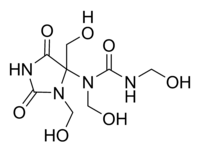This is an old revision of this page, as edited by Yobot (talk | contribs) at 04:49, 26 December 2010 (WP:CHECKWIKI error fixes + general fixes, References after punctuation per WP:REFPUNC and WP:PAIC using AWB (7507)). The present address (URL) is a permanent link to this revision, which may differ significantly from the current revision.
Revision as of 04:49, 26 December 2010 by Yobot (talk | contribs) (WP:CHECKWIKI error fixes + general fixes, References after punctuation per WP:REFPUNC and WP:PAIC using AWB (7507))(diff) ← Previous revision | Latest revision (diff) | Newer revision → (diff)
| |
| Names | |
|---|---|
| IUPAC names
Correct new structure: 1,3-bis(hydroxymethyl)-1-(1,3,4-tris(hydroxymethyl)-2,5-dioxoimidazolidin-4-yl)urea Erroneous old structure: 1-(1,3-bis(hydroxymethyl)-2,5-dioxoimidazolidin-4-yl)-1,3-bis(hydroxymethyl)urea | |
| Other names
Diazolidinylurea Germall II | |
| Identifiers | |
| CAS Number | |
| 3D model (JSmol) | |
| ChemSpider | |
| ECHA InfoCard | 100.071.732 |
| EC Number |
|
| PubChem CID | |
| UNII | |
| CompTox Dashboard (EPA) | |
InChI
| |
SMILES
| |
| Properties | |
| Chemical formula | C8H14N4O7 |
| Molar mass | 278.22 g/mol |
| Hazards | |
| GHS labelling: | |
| Pictograms | 
|
| Signal word | Warning |
| Hazard statements | H317 |
| Precautionary statements | P261, P272, P280, P302+P352, P321, P333+P313, P363, P501 |
| Related compounds | |
| Except where otherwise noted, data are given for materials in their standard state (at 25 °C , 100 kPa).
| |
Diazolidinyl urea is an antimicrobial preservative used in cosmetics. It is chemically related to imidazolidinyl urea which is used in the same way. Diazolidinyl urea acts as a formaldehyde releaser.
It is used in many cosmetics, skin care products, shampoos and conditioners, as well as a wide range of products including bubble baths, baby wipes and household detergents. Diazolidinyl urea is found in the commercially available preservative Germaben.
Commercial diazolidinyl urea is a mixture of different formaldehyde addition products including polymers.
Chemistry
Synthesis
Diazolidinyl urea is produced by the chemical reaction of allantoin and formaldehyde in the presence of sodium hydroxide solution and heat. The reaction mixture is then neutralized with hydrochloric acid and evaporated:
Structure
Diazolidinyl urea was poorly characterized until recently and still has a wrong CAS structure assigned to it. New data show that the hydroxymethyl functional group of the imidazolidine ring is attached to the carbon, not the nitrogen atom:

|

|
| Hoeck structure | previous structure |
Safety
Some people have a contact allergy to imidazolidinyl urea causing dermatitis. Such people are often also allergic to diazolidinyl urea.
References
- HSNO Chemical Classification Information Database, New Zealand Environmental Risk Management Authority.
- ^ Lehmann, Søren Vig; Hoeck, Ulla; Breinholdt, Jens; Olsen, Carl Erik; Kreilgaard, Bo (2006). "Characterization and chemistry of imidazolidinyl urea and diazolidinyl urea". Cont. Dermat. 54 (1): 50–58. doi:10.1111/j.0105-1873.2006.00735.x. PMID 16426294..
- Review of toxicological data (NTP NIEHS)
External links
- "Diazolidinyl urea". MEKOS Laboratories AS. Retrieved 2007-03-11.
